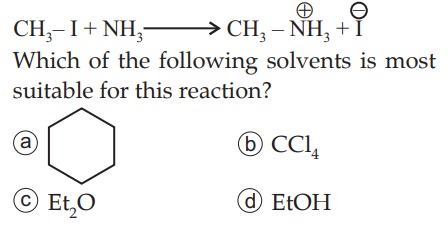Question
Question: $\text{CH}_3\text{-I + NH}_3 \longrightarrow \text{CH}_3\text{-}\overset{\Large \oplus}{\text{NH}}_3...
CH3-I + NH3⟶CH3-NH⊕3+I⊖
Which of the following solvents is most suitable for this reaction?

Cyclohexane
CCl4
Et2O
EtOH
EtOH
Solution
The given reaction is:
CH3-I + NH3⟶CH3-NH⊕3+I⊖
This is a nucleophilic substitution reaction where methyl iodide reacts with ammonia. The products formed are methylammonium ion (CH3-NH⊕3) and iodide ion (I⊖). These are ionic species.
For a reaction that produces ionic products, a polar solvent is essential because polar solvents can effectively solvate and stabilize ions. This stabilization helps to dissolve the ionic products and facilitates the reaction by stabilizing the charged transition state.
Let's analyze the given solvent options:
- Cyclohexane: This is a non-polar, aprotic solvent. It is unsuitable for dissolving or stabilizing ionic species.
- CCl4: Carbon tetrachloride is also a non-polar, aprotic solvent. It is unsuitable for reactions involving ionic species.
- Et2O (Diethyl ether): This is a polar aprotic solvent, but its polarity is relatively low (dielectric constant ~4.3) compared to alcohols or water. While it can dissolve some polar compounds, it is not ideal for stabilizing highly charged ions.
- EtOH (Ethanol): Ethanol is a polar protic solvent. It has a hydroxyl (-OH) group, which allows it to form hydrogen bonds. Polar protic solvents are excellent at solvating and stabilizing both cations (through ion-dipole interactions) and anions (through hydrogen bonding).
Since the reaction produces an ammonium cation and an iodide anion, a highly polar solvent is required to dissolve and stabilize these charged species. Among the given options, ethanol (EtOH) is the most polar and protic solvent, making it the most suitable choice for this reaction.
